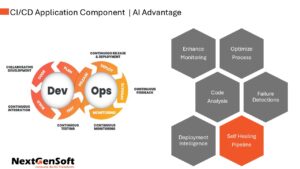Containerization: Empowering Agile Practices in DevOps
Without container orchestration, scaling services become cumbersome, arrangements are error-prone, and manual asset administration leads to wasteful aspects.
DevOps containerization services address these issues by computerizing scaling, disentangling organizations with highlights like rollouts and rollbacks, and optimizing assets utilizing holder organization apparatuses in DevOps.
NextGenSoft gives expert-managed containerization services, advertising custom-made stage administration and maintenance solutions. With best practices for containerization design and advanced DevOps container orchestration, we help your business use the top containerization tools in DevOps, guaranteeing consistent adaptability and productivity while you focus on core operations—partner with us for transformative DevOps containerization services in India.

State-of-the-Art DevOps Containerization Services
- Kubernetes Containerization
- Docker Containerization
- AWS Containerization
- GCP Containerization
- Azure Containerization
- Apache Mesos Containerization
- Atlas Containerization
- MicroService Containerization
- Container Security
Kubernetes Containerization
Let your containers work efficiently with NextGenSoft’s Kubernetes Containerization. Kubernetes experts guide the organization in efficiently implementing and managing containerized applications.
Docker Containerization
Docker containerization presents challenges such as managing and securing container complexity, resource utilization, and consistent performance across environments. NextGenSoft is skilled in addressing these challenges, including designing appropriate, secure solutions, optimizing performance, and integrating containers with existing infrastructures for optimized performance.
Reduce Complexity
Increase Security
Better Resource Management
Offer Portability
Integration
AWS Containerization
Using AWS Containerization allows us to embrace the benefits of container technology while operating within the solid and scalable AWS platform, delivering applications rapidly, and improving operational efficiency.
Amazon Elastic Container Service (ECS)
Amazon Elastic Kubernetes Service (EKS)
Amazon Elastic Container Registry (ECR)
AWS Fargate
GCP Containerization
Containerization advantages on GCP enable organizations to deliver new applications, faster, more securely, and more efficiently, achieving a critical competitive edge.
Google Kubernetes Engine (GKE)
Google Container Registry (GCR)
Cloud Run
App Engine
Azure Containerization
Simplify deployment and management of your containerized applications with Azure Container Services, which provide a complete service set for building, deploying, and managing your containerized workloads on Azure.
Azure Kubernetes Service (AKS)
Azure Container Instances (ACI)
Azure App Service
Apache Mesos Containerization
Unleash the full potential of your distributed applications by leveraging Apache Mesos with help from NextGenSoft using our quality services in cluster setup, framework development, and application deployment. Leverage our expertise, then make better use of Mesos with us, using it where it matters to you, your organization, and your applications across your heterogeneous infrastructure, helping you manage your resources efficiently, scale effectively, and optimize performance.
Mesos Cluster Setup
Mesos Cluster configuration
Mesos Framework Development
Application Deployment and Management
Mesos Integration with Other Tools
Atlas Containerization
Leveraging GCP's containerization services, organizations can achieve a key competitive differentiator—delivering innovative applications faster, more efficiently, and more securely than competitors.
ATLAS Platform Containerization
ATLAS Microservices Containerization
ATLAS Cloud Migration with Containers
ATLAS Security Enhancement with Containers
MicroService Containerization
NextGenSoft offers end-to-end microservices containerization services combining designing, development, deployment, and management of microservices to help you experience flexibility and scale up your containerized architectures.
Managed Infrastructure
Container Orchestration
CI/CD Integration
Security
Monitoring and Logging
Scalability and Elasticity
Developer Tools and SDKs
Container Security
NextGenSoft — Optimize your container security posture with vulnerability scanning, threat detection, and compliance audits to defend your applications and ensure business continuity.
Image Scanning
Runtime Security
Access Control
Network Security
Secret Management
Container orchestration Benefits

Simplified Deployment and Management
An orchestration tool that automates the deployment, scaling, and management of containers across a cluster of machines, which minimizes manual tasks and the potential for human error.
Enhanced Scalability and Availability
Supports auto-adjustment features, automatically scaling applications based on demand to ensure optimal resource utilization and high availability during peak traffic.
Improved Resource Utilization
Provides better resource utilization to containers, thus minimizing waste and optimizing the cost of infrastructure.
Increased Portability
Enables applications to run the same way in different environments simplifying the development testing, and deployment.
Faster Time-to-Market
Simplifies the software development lifecycle, allowing new functionalities and roadblocks (updates) to be delivered faster and more often.
Challenges of Traditional Container Management
Traditional container management tackles huge barriers without the foundation of strong orchestration tools. The management of containers across several hosts by hand is a time-consuming and error-prone process. It can be difficult to allocate resources effectively and efficiently, resulting in resource contention and possible performance bottlenecks. A compromised container image or underlying infrastructure can leave applications open to massive risks, hence securing both is essential. Moreover, orchestrating containers becomes a challenge as applications grow, leading to a requirement for more than just containers; an effective orchestration tool is needed to ensure container portability, facilitate scaling, and guarantee higher availability.
Manual Overhead
Traditional container management is manual and time-consuming, as it requires many deployment, scaling, and monitoring tasks. This results in operational inefficiencies with a higher risk of errors.
Resource Management Challenges
While containers allow for greater flexibility in resource allocation, they can also suffer from performance issues due to insufficient orchestration that results in resource contention among containers—leading to instability and performance bottlenecks.
Security Risks
In regular container management security risk vulnerability of the container, since improper management, as well as the need to ensure the security of the container image and the need to prevent the introduction of malware.
Limited Portability
Unless properly orchestrated, running containers remains hard to do consistently across distinct environments (development, testing, production).
Complexity
Keeping track of your numerous containers spanning across machines can become quite a heavy burden to bear unless you have the right tools.
Best Practice for Containerization Design
Design Architecture for Container Orchestrations
Well-defined microservices architecture starts with a deep dive into the application requirements, considering several factors like dependencies, resources, desired performance, etc. With this groundwork, the architecture outlines how to create, deploy, and manage microservices independently, as well as providing redundancy and fault tolerance; features that promote high availability of microservices to ensure that service delivery continues.
Select Right Orchestration Tool
Container orchestration is a critical component of a successful container strategy, choose the right tools amongst the many Kubernetes, OpenShift, Docker Swarm, Amazon ECS/EKS, etc., and consider scalability and integrations as well as community support for your organizational requirements.
Leverage Infrastructure as Code (IaC)
Leverage Infrastructure as Code (IaC principles), using declarative setup through YAML or Hem charts for containerized deployments and version control for auditability and easy rollback.
Embrace CI /CD process
Promote committing code often and building automatically. Have an effective unit testing strategy. Use code reviews and pair programming to improve the quality of the code. Provide random access for reproduction of deployments in different environments (dev, test, staging, production).
Optimize Container Images
Reduce image size by using a lightweight base image such as Alpine Linux uses multi-stage builds to separate build-time dependencies from runtime dependencies to minimize image size make sure to periodically rebuild the image to patch vulnerabilities and keep dependencies updated.
Secure Your Containers
To secure containers, it is crucial to use the principle of least privilege, docker image scanning (with tools such as Trivy, Aqua Security, or Clair), secrets management (for example, using Kubernetes Secrets, HashiCorp Vault, etc.), and network isolation (with either network policies or firewalls).
Monitor and Log
Implementing effective monitoring and logging in Kubernetes typically involves centralized solutions for log collection and analysis, such as the ELK Stack or using Fluentd or Promtail with Grafana Loki, using tools such as Prometheus, Grafana, or Datadog to collect and visualize performance metrics for the cluster and the applications running within it, and allowing Kubernetes itself to monitor and respond to non-critical failure states with readiness and liveness probes.
Use Blue-Green or Canary Deployments
Perform canary deployment by adding a new smaller version of the application as a deployment configuration.
Backup and Disaster Recovery
Implement regular backups of critical data such as container manifests and persistent storage, and conduct periodic testing of your disaster recovery procedures, to ensure that you can maintain business continuity.
Leverage Namespaces and Labels
Use namespaces to isolate your development, staging, and production environments, and use labels and annotations to do better resource organization, monitoring, and automated operations.
Implement Resource Management
Issue CPU and memory requests/limits; Horizontal auto-scaling to adjust the number of containers up and down as load changes; Vertical scaling to change the resources assigned to containers when required.
Maintain Cluster Hygiene
Keep your cluster clean by regularly cleaning up unused resources like stale images, dangling volumes, and unused services; keeping your orchestrator and plugins up to date with the latest security patches, and taking advantage of new features.
Latest Trends Containerization and Orchestration
Multi-Cloud and Hybrid Cloud Strategies
As flexibility increases and vendor lock-in decreases, organizations are increasingly turning on a multi-cloud and hybrid cloud approach. Kubernetes and other container orchestration platforms are maturing to orchestrate workloads across a variety of environments such as on-premise data centers, public cloud, and edge locations.
Serverless Container Orchestration
Serverless computing and containers are merging to allow developers to focus on code exclusively and eliminate overhead in managing the respective underlying infrastructure. This is facilitated by platforms such as AWS Fargate and Google Cloud Run that automatically scale workloads and manage infrastructure.
AI-Powered Orchestration and Automation
AI/ML in container orchestration is an emerging trend, that helps in predictive scaling, self-healing, and intelligent resource management. By doing so, it helps to boost efficiency and performance when it comes to managing your containerized applications.
Edge Computing and IoT Integration
As the Internet of Things (IoT) expands, along with the demand for real-time data processing, container orchestration is increasingly being adopted in edge environments. Thus lightweight orchestration mechanisms are emerging, designed to handle distributed loads utilizing edge computing to facilitate rapid decision making and low latency.
Simplified Developer Experience
As the container orchestration landscape becomes more complex by the second, the need to enhance the developer experience is on the rise. We see an increasing number of tools that help people develop, deploy, and manage containers more easily — like low-code/no-code platforms and managed Kubernetes services — this shift is allowing developers to spend more time building apps instead of worrying about infrastructure.
Why NextGenSoft?
End-to-End Expertise
Partner with NextGenSoft, a global digital transformation company, and leverage our multi-cloud engineers’ abilities. As a trusted IT solutions provider, we build up secure inter-cloud networks, map native cloud services, and make vendor-agnostic methodologies to maximize esteem and minimize dangers. reach out and Contact Us to learn more
Delivery Excellence
We rethink conveyance fabulousness with optimized program lifecycles. From advancement to arrangement, our digital transformation services and solutions focus on dependable, high-quality discharges that enhance client satisfaction.
Flexible Hiring Model
NextGenSoft’s adaptable contracting models give access to talented IT service providers custom-fitted to your needs. Scale easily with agile assets for DevOps, guaranteeing consistent collaboration and venture victory.
Transparent Actions
Our commitment to straightforwardness builds belief and cultivates cooperation. As a leading digital transformation company in India, we guarantee adjusted objectives, open communication, and compelling collaboration for shared success.
Containerization tools and Technologies
- Container Runtime Tools
- Orchestration Tools
- Container Image Building Tools
- Container Registries
- Networking Tools
- Storage Solutions
- Monitoring and Logging
- Container Security Tools
- GitOps Tools
- Container CI/CD Tools
- DevOps and Development Tools
Container Runtime Tools
Docker
Containerd
CRI-O
Podman
LXC/LXD
Orchestration Tools
Kubernetes
Docker Swarm
Amazon ECS (Elastic Container Service)
Amazon EKS (Elastic Kubernetes Service)
Azure Kubernetes Service (AKS)
Container Image Building Tools
BuildKit
Kaniko
Jib
Buildah
Container Registries
Docker Hub
Quay.io
Google Artifact Registry (GAR)
Azure Container Registry (ACR)
Harbor
Amazon Elastic Container Registry (ECR)
Networking Tools
Cilium
Calico
Flannel
Weave Net
Storage Solutions
Portworx
Rook
Longhorn
OpenEBS
Monitoring and Logging
Prometheus
Grafana
ELK/EFK Stack
Loki
Datadog
New Relic
Container Security Tools
Aqua Security
Twistlock
Sysdig
Falco
Trivy
GitOps Tools
Argo CD
Flux
Weaveworks Flux
CI/CD Tools
GitHub Actions
GitLab CI/CD
Jenkins
Azure DevOps
Google Cloud Build
AWS CodePipeline
CircleCI
TeamCity
Bamboo
Travis CI
DevOps and Development Tools
Minikube
Tilt
Skaffold
Container Orchestration Implementation Strategy

Define Goals and Requirements
Focusing on your goals and requirements will help evaluate how containerization services can bring efficiency. These goals include scalability, high availability, minimizing downtime, assessing your application’s architecture, province, and resource needs, and evaluating your organization’s specific security measures.
Choose the Right Orchestration Tool
Based on your workload needs, and team expertise, and considering variables like cloud vs. on-premises deployment and the accessibility of community support and ecosystem, carefully choose the most reasonable orchestration tool, such as Kubernetes, Docker Swarm, Nomad, Amazon ECS/EKS, Azure AKS, or GKE.
Design the Architecture
Strategize your architecture strategy with a strong focus on cluster sizing and placement, network policies and service discovery definitions, storage choices, (e.g.: Rook, Portworx, cloud-native), and environment segmentation via namespaces.
Prepare Infrastructure
Set up the orchestration tool, Kubernetes for the prepared infrastructure. Depending on the orchestration tool, provision servers, virtual machines, and cloud instances chosen, prepare subnets, firewalls, and load balancers to support the cluster accordingly.
Define Deployment Configuration
Make YAML manifests or Helm charts to characterize and manage deployments, services, and configurations, indicate resource requests and limits to prevent asset contention, and configure liveness and readiness probes to monitor container health and ensure application accessibility.
Implement CI/CD Pipelines
Create Simple yet Powerful CI/CD pipelines for image build and testing automating your pipeline using tools like Jenkins, GitLab CI/CD, or Tekton, and balance runtime workloads using some tools like ArgoCD or Flux for the cluster to keep your image CI/CD auto-deployed, in addition, use strategies such as Canary or Blue-Green deployments to perform safer and controlled visualization when it comes to rollouts on your new versions.
Configure Monitoring and Logging
Implement full-stack monitoring and logging by deploying tools such as Prometheus, Grafana, or Datadog for monitoring both the cluster and application; gain a central view of log data through log collectors like Fluentd, Logstash, or Loki; set up alerts for critical system downtimes, high resource utilization, or suspicious activities.
Enforce Security Measures
Use network policies to control communication between pods and services Implement Role-Based Access Control (RBAC) to provide permissions based on roles and responsibilities. Sensitive Data Use Kubernetes Secrets or HashiCorp Vault to manage sensitive information, configure secrets to control access and rotate secrets regularly. Scan Container Images for Vulnerabilities Use tools like Trivy or Aqua Security to recognize vulnerabilities in container images.
Scale and Optimize
Leveraging Horizontal Pod Autoscaling (HPA) to scale and optimize your deployment automatically changes the number of units based on resource usage. With the help of cluster autoscaling, dynamically include or remove nodes from the cluster as needed, and design ingress controllers and external load balancers to spread traffic across your application.
Conduct Testing
Test extensively; Load Testing – to check whether your system is working and performing under both regular and expected loads and peak loads; Chaos Engineering testing – utilize Chaos Mesh or Gremlin to test resilience – or rollback testing to ensure the ease and effectiveness of return to stability after a failure.
Monitor, Maintain, and Iterate
Continually track and analyze system health and performance parameters, regularly update your orchestration tools, plugins, and container images, and leverage those insights to optimize your architecture design, configurations, and processes.
Enhance Containerization with Our DevOps Expertise

Cloud DevOps Services
Leverage cloud-native DevOps to automate deployments, optimize infrastructure, and ensure high availability with AWS, Azure, and GCP.

CI/CD Services
Automate software delivery with streamlined CI/CD pipelines, enabling faster releases, improved quality, and reduced manual effort.

DevOps Assessment
Evaluate and optimize your DevOps maturity with strategic insights, automation recommendations, and workflow improvements.

DevSecOps Services
Embed security into your CI/CD pipeline with automated compliance, vulnerability management, and threat mitigation.
FAQs
-
What is containerization in DevOps?
Containerization in DevOps involves typifying applications and their conditions into convenient, lightweight holders. This guarantees reliable and solid situations across development, testing, and generation stages, streamlining DevOps workflows and enhancing proficiency. -
What is the main benefit of using containerization in DevOps?
The primary benefit is improved versatility, transportability, and asset productivity. Combined with container orchestration tools in DevOps, it gives consistent environment consistency, quickens processes, and dispenses compatibility issues across stages. -
What is container orchestration in DevOps?
Container orchestration automates the sending, scaling, and administration of containerized applications utilizing tools like Kubernetes, guaranteeing proficient asset use and steady application accessibility. -
What is orchestration in DevOps?
Orchestration in DevOps rearranges complex workflows, mechanizing errands such as sending, scaling, and setup to upgrade process productivity and diminish operational overhead. -
Which tool is used for container orchestration?
Kubernetes is the leading tool for container orchestration in DevOps, empowering mechanized administration, scaling, and arrangement of containerized applications consistently. -
What are Containers in DevOps?
Containers in DevOps are lightweight, standalone units that package an application with all its conditions, ensuring consistency over situations and streamlining deployments. -
What is container management in DevOps?
Container management in DevOps includes handling containerized applications' lifecycle, including deployment, scaling, and observing, utilizing tools like Docker and Kubernetes for consistent operations.
Contact us

Submit Your Inquiry

Detailed Proposal

Collaborate and Plan









































































